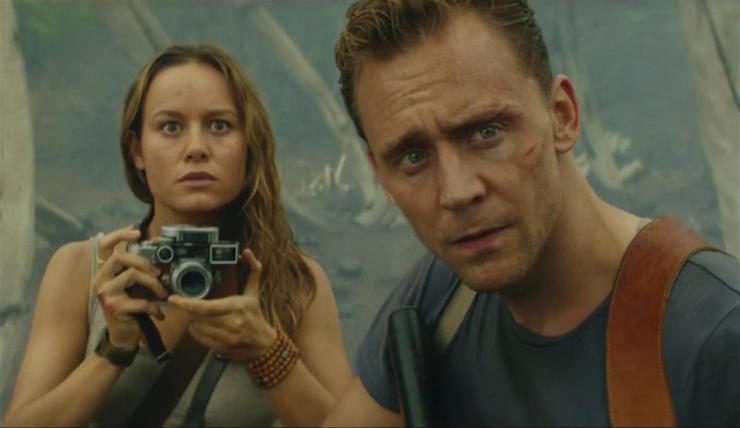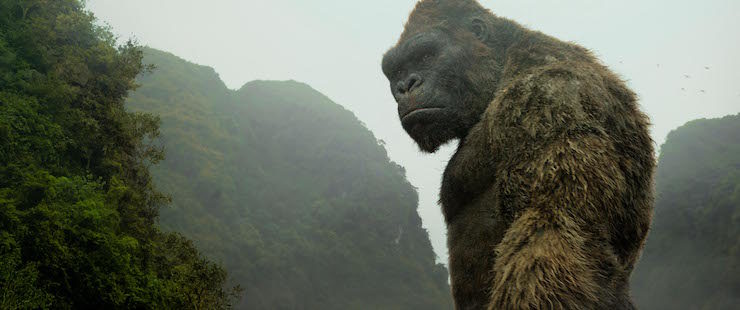Kong: Skull Island is not the movie you think it is. Or rather, it’s not just the movie you think it is.
It is the latest update to the story of King Kong. You do get Skull Island (of course), you do get lots of Kong being a genuinely impressive frightening physical presence. You also get lots of other Skull Island denizens. There’s even a film camera rolling, although the footage is being shot for very different reasons than in the original King Kong.
All of this is handled very well, too—in fact, director Jordan Vogt-Roberts and cinematographer Larry Fong have created what may be the definitive Skull Island. There’s none of the rubbery CGI that damaged the Peter Jackson version so badly, and every one of the island’s denizens has believable mass and physical presence. That in turn means that this Skull Island feels like what it should be: a horrifically dangerous place, almost chthonic in nature. There’s one moment in particular in which Chapman (Toby Kebbell, who also helped out on motion capture for Kong) sees Kong up close and personal, and it’s truly awe-inspiring. This Skull Island is an ecosystem like no other, and the characters, as well as the audience, are uninvited guests.
But it’s also a surprisingly multifaceted and often beautiful place. Vogt-Roberts and Fong continually find unexpected moments of grace and tranquility on this island of colossal death. A scene where Kong emerges from the fog is a standout, as is the gloriously icky reveal of a moss-covered spider the size of a building stalking a group of characters. And there are two moments, both featuring a colossal water buffalo, that are honestly breathtaking. Neither scene features any threat or violence but both convey the immediate and visceral sense of being face to face with an animal that is immense, alien, and calm. These little grace notes are scattered through the movie and they make Skull Island feel like a real place in a way it never has before. Vogt-Roberts and Fong also constantly place the action in a visual context that makes it easier to comprehend: the fights are brutal, scrappy, and easy to follow because there’s almost always a human involved for scale.
The Skull Island natives are also surprisingly well-handled. Where previous versions have imagined the islanders as a nihilistic death cult straight out of the pulps, this version does something better, adding some extra dimensions to the portrayal of its indigenous people, as it does with the island itself. The impression you’re left with is of a culture that is both very well developed and very cautious, and its people have learned to coexist with the vast animals with which they share the island. They’re still, unfortunately, essentially window dressing for all that, but they’re not as offensively so. And, given previous versions of this movie, that constitutes a definite improvement.

Where the film gets really surprising, though, is in its focus. While the trailers featured Tom Hiddleston’s James Conrad and Brie Larson’s Mason Weaver, neither of them really have an arc. Oh, they have plenty to do—and a sequence involving Hiddleston, poison gas, a samurai sword, and carnivorous bat-birds is immense fun—but neither character really develops. At the start of the movie we’re told Conrad is an embittered former Special Forces soldier turned tracker. That’s also where he is at the end. Likewise, Weaver’s anti-war photojournalism is still her defining characteristic at the close of the movie. That should be a bad thing and yet…somehow, it’s not.
There are, however, characters that the film gets very badly wrong—Jing Tian’s Lin has so little to do, it’s comparable to how badly the 2014 Godzilla wasted Sally Hawkins. Similarly, the roles played by the wonderful Marc Evan Jackson (Sparks Nevada himself) and the excellent John Ortiz are reduced to little more than their characters looking worried in the background.
While these characters barely qualify as such, though, the film really steps up with the rest of the cast. John C. Reilly, who looked suspiciously like a movie killer in the trailers, is actually at his best here. Playing Marlow, a pilot shot down over Skull Island during World War II, he’s erratic and deadpan but also really very sweet. Likewise, Samuel L. Jackson does excellent work as Preston Packard, the helicopter assault force leader who jumps at the chance for one more operation as the Vietnam War winds down.
And that’s the ace hiding up Kong: Skull Island’s massive sleeve; it’s actually a Vietnam movie. Or more specifically, a war movie.
Beginning on the final day of the Vietnam War, Skull Island’s dramatic heavy lifting is almost all done by the Sky Devils, and Jackson in particular is great as an officer who does monstrous things for absolutely understandable reasons. It would be so easy for him to tip over into self-parody and he never once does so. Instead, he shows us Packard as a fundamentally good soldier who doesn’t know how to be anything else. Unable to cope with first the war, then his squadron, being cut out from under him, he becomes an Ahab-like figure. That pays dividends for the movie as his surviving troops slowly realize that, unlike him, their war is definitely over.

His opposite number, aside from Kong, is John Goodman’s James Randa. Goodman and Jackson are two of those actors who don’t know how to turn in bad work and they’re both in top form here. Goodman in particular carries the entirety of the movie’s secret organization plot (namely, Monarch, which first appeared in the most recent Godzilla) and he does so with authority and moments of real darkness. Packard wants a war. Randa wants an enemy. The two men orbit around each other in a tightly wound web of mutual dependency and mistrust that’s really fun, and one of the few things the movie could have afforded to spend more time with.
But the rest of the Sky Devils are the characters you’ll remember. Jason Mitchell and Shea Whigham are especially great: as Mills and Cole, they’re the Rosencrantz and Guildenstern of the movie, and illustrate again just how surprising this film is. A lesser script would have had Mitchell stereotyped as the hysterical comic relief. Here he’s a bone-dry wit who is both the translator for, and understudy to, Whigham’s Cole. Whigham, who had a memorable turn in Season 1 of Agent Carter, does stunning work here. Cole is serene, very funny, and clearly more than a little broken. He’s the cool older brother to the rest of the squadron, a moral compass for them, and a figure who commands every scene he’s in. You care about these two soldiers in particular and, given the fact that these actors aren’t big names, that lends welcome tension to many of the action scenes. And Thomas Mann is great as Slivko, who possesses absolutely none of the chill that Cole and Mitchell have, but does have a portable record player and provides the film with its fitting, Vietnam-era rock score.
The stroke of genius here is that Kong actually occupies the position Packard dreams of. Kong is the last soldier on the battlefield, and the notion that he and his family were the only thing standing between the island and the horrific creatures that live beneath its surface puts the character in a very relatable context. This is Kong as Rocky Balboa, wounded and frightened and with no idea how to quit fighting. The reptilian Skull Crawlers also provide a welcome dose of horror in the movie, raising the stakes once again and really making you root for the big guy. Packard wants a war. Kong wants anything but a war, and the conflict between the two is thematically chewy and deep. Terry Notary and Toby Kebbell’s collaborative performance shines through as well, and this Kong isn’t just one of the largest versions of the iconic character, but clearly the most intelligent.

All of this combines to make Kong: Skull Island quite unlike anything else you’ll see this year. It’s complex and deep and still, somehow, largely involves a huge gorilla punching things in the face a lot. Vastly more thoughtful, more interesting, and fundamentally more fun than 2014’s Godzilla, it’s the most engaging giant monster movie in recent memory to not feature any Jaegers. Yet.
And do stay through the end credits: the sting is brilliant.
Alasdair Stuart is a freelancer writer, RPG writer and podcaster. He owns Escape Artists, who publish the short fiction podcasts Escape Pod, Pseudopod, Podcastle, Cast of Wonders, and the magazine Mothership Zeta. He blogs enthusiastically about pop culture, cooking and exercise at Alasdairstuart.com, and tweets @AlasdairStuart.










